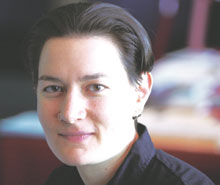Anyone can enjoy Yiddish, says visiting scholar

Rebecca Margolis
Photo by Andrew Dobrowolskyj
With her nose ring, short straight hair, and pale skin set off by a stylishly all-black outfit, Rebecca Margolis may not be your idea of a scholar of Yiddish, the lingua franca of East European Jews prior to the Holocaust.
In fact, at 30, Margolis is already an expert on Yiddish Montreal before 1940. She is currently a visiting scholar-in-residence at Concordia’s Institute for Canadian Jewish Studies and was assistant coordinator of the trilingual conference, New Readings of Yiddish Montreal, held last week at the university.
It is her generation of scholars, and younger, who hold the best hope for the survival of the language’s rich cultural heritage. And they really don’t have to be Jewish to love Yiddish, brought to the New World by successive waves of immigrants.
“One of the key things in the area of Yiddish today is to get younger people and young scholars to further the scholarship we have, and not just scholars from within the Jewish community but from outside who are interested in ethnicity and culture and music and in the various areas that existed in the Yiddish world,“ Margolis said during a break in the conference which drew more than 120 participants and about 20 speakers.
She has such budding researchers among the 20 students taking her course at Concordia, The Montreal Yiddish Experience, and whom she encourages to do their own primary research.
Today, Yiddish is used only by a shrinking number of elderly people, excluding the closed religious communities of Hassidic sects, but it used to be the mother tongue of a lively secular world that produced numerous publications as well as institutions such as libraries and schools.
“That was one thing that I found amazing in my research – it was an international community, “ said Margolis, herself a product of Montreal’s Jewish day school system.
“It was an incredibly fluid world, where through the press and the postal system and modern transportation Yiddish cultural figures could travel huge distances — even for us today, huge distances — back and forth between America and Europe, read each other’s works, hear each other speak, correspond with each other extensively.”
Montreal was a key centre of this world, with a culturally humming community in the early part of the 20th century that became the primary destination for leading Yiddish literary figures who had survived the Holocaust.
“Yiddish immigrants who came to the city, in their memoirs, take note on how lively the Yiddish cultural life is in this city, even in 1913, compared to other cities,” Margolis said. “You could walk down St. Lawrence Boulevard, The Main, and hear Yiddish spoken and see Yiddish signs. This was something that amazed them.“
The March 10-11 conference reflected a renewed interest in the city’s Yiddish legacy, in making it accessible to a larger public.
“This conference focuses on issues of translation and transmission and the reinvention of Yiddish to the non-Yiddish world,“ Margolis said, noting that proceedings took place in French, English and Yiddish.
Speakers included québécois scholars such as the Université de Montréal’s Pierre Nepveu, a well-known theorist of translation, Jean-Marc Larrue of Collège Valleyfield, who has an interest in Yiddish theatre, and Pierre Anctil of the Institut québécois d’études sur la culture juive.
The conference also explored the influence of Yiddish on the work of current Canadian Jewish writers such as Robert Majzels and Concordia’s Norman Ravvin.
Margolis, who got really hooked on Yiddish as an undergraduate at McGill, has been at Columbia University for the past six years and is completing her doctoral dissertation on Yiddish literary culture in Montreal until 1940.
Her favourite Jewish writer is Mordecai Richler, for his affectionately critical examination of a period that is her field of expertise. Like most Yiddish scholars of her generation, she does not curl up with a good Yiddish novel for relaxation.
“Which is unfortunate, because there are fewer and fewer people using Yiddish literature for the purpose it was created, which was really entertainment or edification. Most of us study it.”